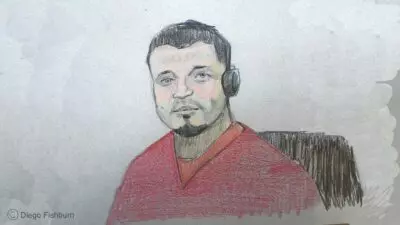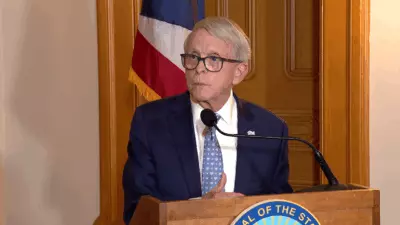Country music stars are singing about farmland loss. Will it raise awareness and make a difference?

My brother called me from his car on a Tuesday night. After talking for a few minutes, he mentioned a song that had just finished playing on the radio. Justin Moore’s “This Is My Dirt” speaks to my writing and work, he said.
I had heard the song before, but I gave it another listen. This time, I pulled the lyrics up and read along.
Moore’s song tells the story of a farmer who is approached by a real estate developer. Pulling up next to the barn, the developer steps out of his car and introduces himself. He tells the overalls-clad farmer—a tired stereotype of America’s agrarians, even if my farming grandfather wore Liberty bibs every day for decades—that he builds houses and neighborhoods. Then he asks: “I was wondering if you’d ever want to sell your farm?”
No, the farmer says. He acknowledges the temptation, but he can’t sell the land his family has tended for so long. “The money’d be great,” he admits, alluding to the struggles that have led to a massive decline in the number of small and midsized farms in the last few years. “But I can’t part ways with a life that works. You can’t put a greenback dollar on what it’s worth. This is my dirt.”
To some, especially those who may be less familiar with farming communities, Moore’s lines might sound nostalgic, even cliché. In a broader culture that, as conservationist Aldo Leopold once wrote, values land as a commodity to be traded rather than a community to be tended, the lyrics may sound out of touch.
But I have heard the same words when speaking with farmers across the country. Their stories and experiences reveal a powerful devotion to place.
In my book Love for the Land: Lessons from Farmers Who Persist in Place, I share stories and insights from a few dozen farmers, land conservationists, and local leaders. In one interview, a farmer told me that he had been offered $40,000 an acre for his land, money that would make him an instant millionaire. Just like in Moore’s song, an eager developer had stopped by his house, a cold call with cold hard cash. Borderline offended by the proposition, that farmer said,“I wouldn’t sell it to nobody at all.”
Another farmer told me that if someone offered big bucks to convert his family’s land into subdivisions or strip malls, “I’d tell them to go to hell.” I laughed at his remark, assuming it was a joke.
He didn’t laugh. It wasn’t a joke.
Yet another farmer captured many others’ comments when she said, “The easy way out would have been to quit a long time ago. I have a lot of road frontage here,” she continued, “and I could have divided it and been gone and been financially well-off. But we don’t want that path. We’re willing to scrounge each year and keep working at it.”
I asked these farmers what motivated their actions. Why were they turning down millions of dollars, easier lives, and the promise of less physically demanding work? Why do what’s hard instead of what’s easy? Why stay instead of sell?
They shared that love drives their resilience. In the face of all sorts of adversity—challenges posed by agricultural consolidation; threats from farmland conversion; injustices that farmers of color have faced for centuries and still face today—it is affection, rooted in a deep connection with the land itself, that inspires their devotion and care.
“This Is My Dirt,” which was co-written by Jeremy Stover, Randy Montana, and Paul Charles Digiovanni, resonates with these real-life stories. The song isn’t sentimental, or at least not purely so. It’s honest.
Moore isn’t the only country artist to sing about these themes. In fact, there has been a flurry of songs about farmland loss, and resistance to it, released over the last year.
Matt Stell put out “Smooth,” co-written with Chris Destefano. It describes how life became less enjoyable for a family after they sold the farm, even though the sale netted them a hefty profit.
Cody Johnson released “Dirt Cheap,” written by Josh Michael Phillips. It’s a moving song where an aging farmer tells a developer, who has yet again shown up unannounced, that whatever price he offers “won’t be enough.” The farmer describes the land as a gift to cherish, echoing the words of farmer-writer Wendell Berry, and sees his family’s past, present, and future intertwined with the farm.
And in August, Sugarland released “There Goes the Neighborhood,” which was co-written by Connie Harrington, Ryan Hurd, and Maren Morris. In it, farmland is turned into a subdivision, a sign of “progress.” “Gone forever in a day,” Jennifer Nettles sings. “Subdivide, give it a name.” The subdivision in Sugarland’s song is called “Shady Acres.” To make way for new buildings, the housing developers pushed down all the trees.
The artists above aren’t the first to lift up these issues. We can think back to Malvina Reynolds’ 1962 song “Little Boxes” or The Pretenders’ mid-1980s tune “My City Was Gone,” where lead singer and songwriter Chrissie Hynde belts that “the farms of Ohio had been replaced by shopping malls.” In the late 1990s, Montgomery Gentry released “Daddy Won’t Sell the Farm.”
Even if they don’t focus an entire song on farmland conversion, other artists have slipped not-so-subtle lines into their lyrics. Luke Bryan’s “Here’s to the Farmer” mentions subdivisions creeping in, threatening to overtake fields and pastures. Jason Isbell’s “Last of My Kind” calls out a family farm becoming a Wal-Mart parking lot.
Musical emphasis on land conversion and sprawl isn’t new. Still, it’s notable that so many artists, all of whom have found mainstream success, covered this same theme within a year.
It’s also ironic. Nashville, the same city that pumps country music out to the world, the mecca of honkytonks and steel guitars and over-priced boots on Broadway, is one of the biggest drivers of farmland loss in the United States.
Projections suggest that if recent trends continue, Tennessee will lose more than a million acres of agricultural land in the next two decades. Nashville’s explosive growth is driving much of that conversion. It is transforming many of the once-rural communities on its edges.
We know this from satellite imagery, university studies, and Census of Agriculture findings, but we can also see it firsthand. My family’s small farm is about 40 miles south of Nashville. Parts of that area are nearly unrecognizable from what they were fifteen years ago.
Tennessee isn’t alone, though. Farmland conversion is an issue around the country. American Farmland Trust suggests that the United States is on pace to compromise nearly 20 million acres of agricultural land by 2040, an area roughly the size of South Carolina. These projections, the research notes, are conservative.
The erasure of agricultural landscapes is a real problem. It destroys wildlife habitats, impacts the climate, and harms rural economies. It throttles the capacity of local and regional food systems. It can lead, at times, to rural gentrification.
Growth itself isn’t a bad thing. It can be beneficial. But in some areas, growth is happening at such a breakneck pace that we’re sacrificing the places that sustain us. We’re not being thoughtful enough about decisions that will alter our landscapes forever.
Songwriters and artists have taken note. Perhaps they’ve seen bulldozers grading soil and pushing down barns as they drive in and out of Nashville for recording sessions. Maybe they’re from rural areas themselves that have undergone drastic changes. Maybe they’re concerned about where their food comes from.
Whatever the case, I’m glad they’re warning listeners, and I’m thankful they’re uplifting stories of farm families who persist and persevere—and doing so in a medium that can reach millions of people.
When driving to work or school or supper with the radio on, I hope we do more than hum along to these songs. I hope we listen. Paving over pastures isn’t necessarily a sign of progress. Conserving farmland, and meaningfully supporting people who want to remain on the land or, for the next generation, start a life in agriculture, is essential.
Can these songs help us understand that?







